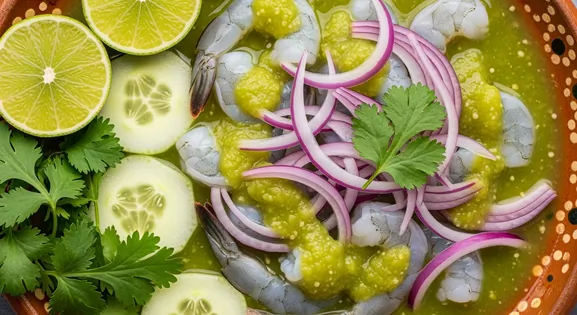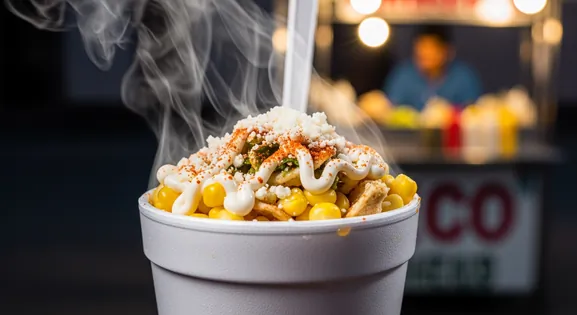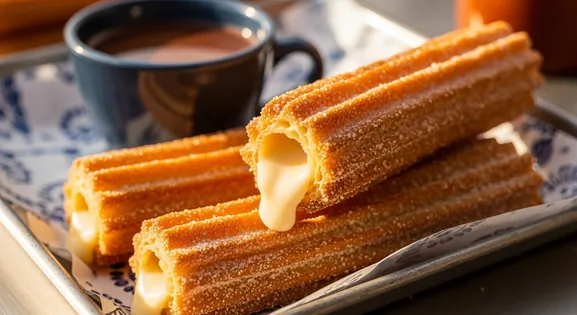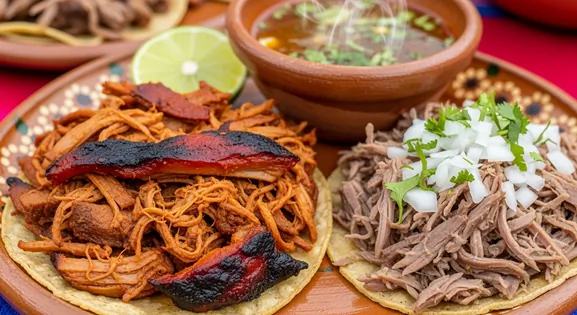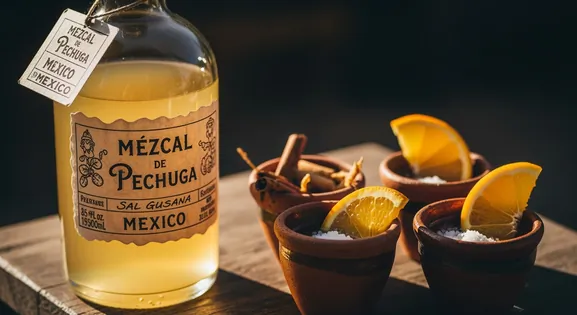Chapulines in Mexico: A Complete Food Lover's Guide
Chapulines
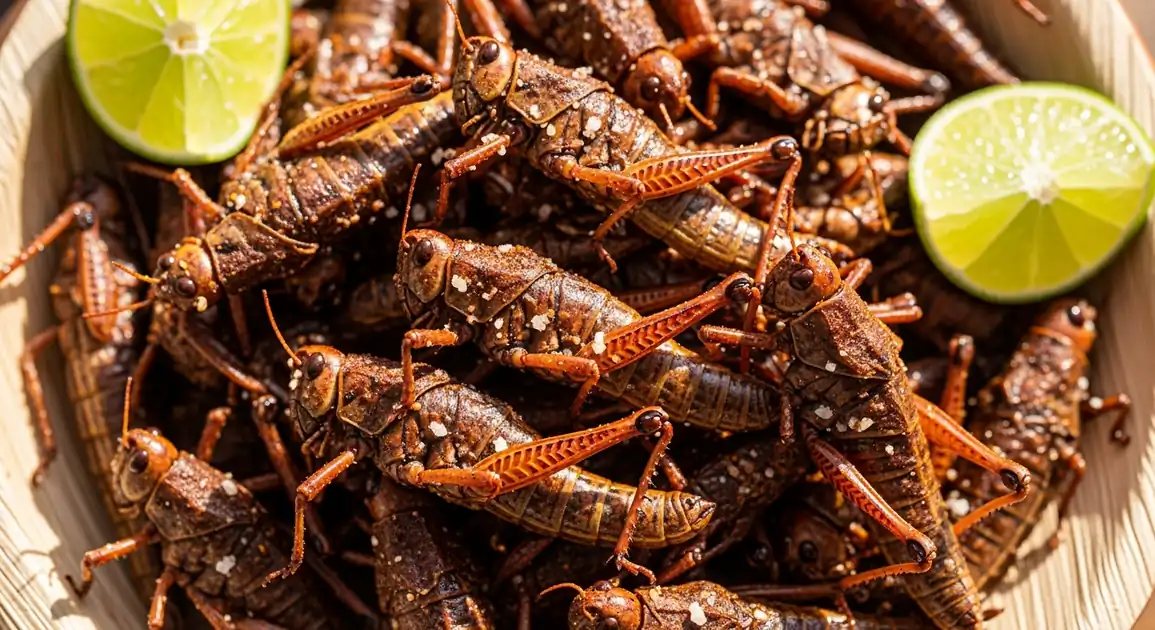
What is Chapulines (Toasted Grasshoppers)?
Chapulines are toasted grasshoppers, a traditional Mexican delicacy particularly associated with Oaxaca state. These protein-rich insects are seasoned with lime, salt, garlic, and chile, creating a crunchy, tangy snack with a subtle earthy flavor. Harvested from agave fields, properly prepared chapulines have a distinctive reddish-brown color and are consumed either as a standalone snack or as a topping for traditional dishes like tlayudas, tacos, and guacamole.
The Culinary Legend of Chapulines (Toasted Grasshoppers)
Chapulines have been consumed in Mexico since pre-Hispanic times, with archaeological evidence dating back thousands of years. Indigenous peoples, particularly Zapotecs and Mixtecs in what is now Oaxaca, harvested these protein-rich insects as a sustainable food source. The Spanish conquest documented their culinary use in the 16th century. Traditional preparation methods have been passed down through generations, with each region developing particular seasoning preferences. While historically associated with rural and indigenous communities, chapulines have gained popularity nationally and internationally as interest in traditional Mexican cuisine and sustainable protein sources has grown.
Traditional Preparation Techniques
Chapulines are typically harvested from agave or corn fields, primarily during the rainy season when they're most abundant. After collection, they undergo a thorough cleaning process to remove legs, wings, and internal organs. They're then washed multiple times to ensure cleanliness. The crucial preparation step involves toasting them on a comal (flat griddle) until completely dry and crispy. While still hot, they're seasoned with lime juice, salt, garlic, and sometimes chile or other spices according to regional preferences. The lime juice not only adds flavor but also helps preserve them. Quality preparation requires careful attention to ensure they're thoroughly cooked without burning, which would create bitter flavors.
Key Ingredients of Chapulines (Toasted Grasshoppers)
Grasshoppers (Chapulines)
The core ingredient, these small, protein-rich insects are typically harvested from agave or corn fields. Their quality is paramount for flavor and texture.
Quality indicator: Look for a uniform reddish-brown color and intact bodies, indicating proper toasting and handling.
Lime Juice
Freshly squeezed lime juice is essential for seasoning, providing a tangy counterpoint to the earthy grasshoppers and aiding in preservation.
Quality indicator: The aroma should be bright and citrusy, not dull or artificial.
Garlic
Finely minced or powdered garlic adds a pungent, savory depth to the chapulines, complementing their natural flavor and enhancing the overall savory profile. It's a crucial component of the seasoning blend, contributing to the distinctive taste.
Quality indicator: A strong, fresh garlic aroma is a sign of quality seasoning.
Local Chapulines (Toasted Grasshoppers) Variations in Mexico
Chapulines with Chile
Seasoned with additional chile powder or sauce for a spicier flavor profile. Popular in central Mexico.
Garlic Chapulines
Emphasis on garlic flavor with minimal chile, often preferred by those who enjoy the natural taste of the insects without too much heat.
Chapulines with Epazote
Traditional Oaxacan preparation including epazote herb, which adds an aromatic, minty flavor and is said to aid digestion.
Large Chapulines
Larger specimens, often sorted specifically for their size. They have a more substantial crunch and are typically more expensive.
Small Chapulines
Smaller, younger grasshoppers with a more delicate texture. Often preferred for adding to dishes as they integrate better.
What to Serve with This Dish
Mezcal
Spirit
The smoky, earthy notes of traditional Oaxacan mezcal create a harmonious and authentic pairing with the savory, crunchy chapulines, often served as a bar snack.
Guacamole
Dip
The creamy, rich avocado of guacamole provides a cooling contrast to the crunchy, seasoned chapulines, which are often sprinkled on top for added texture and flavor.
Spotting Quality: What to Look For
What to Look For
-
Uniform reddish-brown color
Properly toasted chapulines should have a consistent color without black (burnt) or pale (undercooked) specimens.
-
Completely dry and crispy texture
Chapulines must be thoroughly toasted to eliminate any pathogens and ensure food safety. They should snap when broken, not bend.
-
Clean, sorted product
Quality vendors carefully clean and sort their chapulines, removing debris, dirt, and extraneous parts.
-
Fresh, aromatic smell
Good chapulines have a pleasant aroma of lime, garlic, and chile. Avoid any that smell musty, rancid, or off.
-
Vendors with high turnover
Busy stalls typically have fresher product and maintain better quality control.
What to avoid
-
Damp or soft chapulines
Inadequately toasted chapulines may contain harmful bacteria. They should never feel moist or soft to the touch.
-
Black or very dark specimens
Burnt chapulines taste bitter and may contain harmful compounds from overcooking.
-
Chapulines with visible dirt or debris
Poor cleaning indicates substandard preparation practices that may impact food safety.
-
Stale or off-smelling product
Old or improperly stored chapulines can develop mold or rancidity. They should smell fresh and appetizing.
-
Exceptionally cheap prices
Quality chapulines require labor-intensive preparation. Suspiciously low prices may indicate shortcuts in cleaning or preparation.
Explore Chapulines (Toasted Grasshoppers) in Detail: City Guides
Discover where to find the best Chapulines (Toasted Grasshoppers) and learn local tips in these cities:
Dietary Information
Dietary Information
Important Note for Travelers: Your safety is our priority. Below are the common allergens associated with the traditional preparation of this dish. However, recipes and ingredients can vary significantly between establishments. Always confirm all ingredients directly with the food vendor before ordering, especially if you have a severe allergy.
Potential Allergens
Dietary Suitability
How to Order Chapulines (Toasted Grasshoppers)
Frequently Asked Questions about Chapulines (Toasted Grasshoppers)
What are Chapulines?
Chapulines are toasted grasshoppers that have been a traditional food in Mexico, particularly Oaxaca, since pre-Hispanic times. They're typically seasoned with lime juice, salt, garlic, and chile, giving them a tangy, savory flavor. After harvesting, they're cleaned, toasted on a comal (flat griddle), and seasoned. They're valued for their crunchy texture, distinctive flavor, and high protein content.
How do Chapulines taste?
Chapulines have a distinctive savory, earthy flavor often described as nutty or shrimp-like. The taste is heavily influenced by their seasonings: lime juice provides tanginess, chile adds spice, and garlic contributes depth. Their flavor is sometimes compared to sunflower seeds or dried shrimp. The texture is crunchy and light, similar to small crispy snacks.
Are Chapulines a good choice?
Properly prepared chapulines from reputable vendors are generally a good choice. Look for vendors who clean them thoroughly and toast them completely (they should be dry and crispy). People with shellfish allergies should avoid chapulines as they contain chitin, similar to shellfish. First-timers should start with small amounts. Choose vendors with high turnover and good hygiene practices.
How are Chapulines typically eaten in Mexico?
Chapulines are versatile. They're commonly eaten as a snack straight from the bag, often with a squeeze of lime. They also serve as a crunchy topping for dishes like tlayudas, tacos, and guacamole. Some restaurants incorporate them into tamales or salsas. In Oaxaca, they're often paired with mezcal.
Can people with shellfish allergies eat Chapulines?
People with shellfish allergies should avoid chapulines. Grasshoppers contain chitin in their exoskeletons, which is chemically similar to the compounds in shellfish that trigger allergic reactions. Medical studies have documented cases of cross-reactivity between insect and shellfish consumption. If you have a shellfish allergy, it is advisable to avoid chapulines altogether.
What nutritional benefits do Chapulines provide?
Chapulines are highly nutritious, offering an excellent source of protein (up to 70% dry weight) and all essential amino acids. They are rich in calcium, iron, magnesium, and zinc, plus fiber and low in fat. Their ecological footprint is significantly smaller than traditional livestock, making them a sustainable protein source.
Expert How-To Guides about Chapulines (Toasted Grasshoppers)
How to Select Quality Chapulines
Learn to identify fresh, properly prepared chapulines for the best experience.
- Look for uniform color: Good chapulines should have a consistent reddish-brown color without dark or black pieces (which indicate burning).
- Check for complete toasting: They should be completely dry and crispy, with no soft or damp parts.
- Smell before buying: Fresh chapulines have a pleasant, aromatic smell with notes of lime, chile, and garlic. Avoid any that smell musty or off.
- Observe size consistency: Quality vendors sort their chapulines by size. Mixed sizes often indicate less careful preparation.
- Check for cleanliness: There should be no dirt, debris, or excessive unidentifiable parts mixed in.
- Sample if possible: Many vendors offer small tastings. The flavor should be clean and pleasant, not bitter or rancid.
How to Eat Chapulines for Beginners
First-timer's guide to confidently enjoying this unique and traditional Mexican delicacy, ensuring a pleasant culinary adventure.
- Start small: Begin with just a few chapulines to get accustomed to the texture and flavor.
- Pair with familiar foods: Try them first as a topping on guacamole, mixed into salsa, or sprinkled on tacos.
- Add fresh lime: A squeeze of fresh lime juice enhances the flavor and is traditionally how they're enjoyed.
- Chew thoroughly: The crispy texture is part of the experience, and proper chewing helps with digestion.
- Have a drink handy: Traditionally paired with mezcal, but water or beer works well for beginners.
- Build gradually: If you enjoy them, slowly increase the quantity to allow your digestive system to adjust to this protein-rich food.
How to Store Chapulines at Home
Essential techniques for storing chapulines at home, ensuring they remain fresh, crispy, and delicious for extended enjoyment.
- Keep them dry: Moisture is the enemy of properly toasted chapulines. Store in an airtight container.
- Avoid heat: Store away from direct sunlight or heat sources to prevent spoilage.
- Refrigerate for longer storage: For keeping more than a few days, refrigeration in an airtight container works best.
- Check before consuming: If they develop an off smell or visible mold, discard them.
- Refresh if needed: If they become less crispy, you can re-toast them lightly on a dry pan for a few minutes.
- Freeze for long-term: For extended storage, freeze in an airtight container for up to three months.
Our Commitment to Quality
At Tasteplorers, our mission is to provide the most accurate and useful travel information in the world. To achieve this, all content on this site is created through our unique editorial framework. We utilize leading AI research tools, guided by our proprietary prompts, and a multi-stage validation process. This entire system is overseen by our editorial team to ensure everything we publish meets our high standards for accuracy, cultural nuance, and practical value for travelers.
Learn more about our Editorial Process and our Mission.
Explore regions
Europe
Discover Europe's diverse culinary landscape, from Mediterranean flavors to hearty Alpine fare. Learn to navigate markets, decode menus, and eat like a local.
Latin America & Caribbean
Discover the vibrant cuisines of Latin America & the Caribbean. Our expert guide covers everything from Mexican street food to Peruvian ceviche and market tips.
Oceania
Explore Oceania's diverse food scene. Learn about Polynesian earth ovens, Fijian feasts, and the vibrant café culture of Australia and New Zealand.
Southeast Asia
Explore Southeast Asia's diverse food cultures from Thailand to Vietnam. Get expert tips on navigating spice levels, choosing quality vendors, and understanding the rich traditions of the region.
